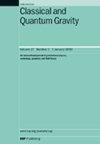用于 LISA 的快速多模式参数估计技术
IF 3.6
3区 物理与天体物理
Q2 ASTRONOMY & ASTROPHYSICS
引用次数: 0
摘要
激光干涉仪空间天线(LISA)将观测来自各种信号源的引力波(GW)信号,包括大质量黑洞双星(MBHBs)。虽然为 LISA 开发了许多贝叶斯推理技术,但这些技术的计算成本往往很高;即使使用加速技术,单个 CPU 的分析时间也至少需要 1 个月~1 个月。这不仅使同时分析一个以上的 GW 信号变得困难,也使为可能的电磁跟踪活动快速生成参数估计变得具有挑战性。最近开发了 simple-pe,用于为地面 GW 探测器观测到的 GW 信号快速生成参数估计。在这项工作中,我们对 simple-pe 进行了扩展,以快速估算 LISA 信号源的参数,包括高阶多极矩的影响。我们的研究表明,simple-pe 在零噪声条件下推断大质量黑洞双星的源属性至少比现有技术更快;而且只需一个 CPU。我们进一步证明,simple-pe 可以在现有贝叶斯技术之前应用,以减轻 MBHB 多模式参数估计分析中的偏差。本文章由计算机程序翻译,如有差异,请以英文原文为准。
A rapid multi-modal parameter estimation technique for LISA
The laser interferometer space antenna (LISA) will observe gravitational-wave (GW) signals from a wide range of sources, including massive black hole binaries (MBHBs). Although numerous techniques have been developed to perform Bayesian inference for LISA, they are often computationally expensive; analyses often take at least ∼1 month on a single CPU, even when using accelerated techniques. Not only does this make it difficult to concurrently analyse more than one GW signal, it also makes it challenging to rapidly produce parameter estimates for possible electromagnetic follow-up campaigns. simple-pe was recently developed to produce rapid parameter estimates for GW signals observed with ground-based GW detectors. In this work, we extend simple-pe to produce rapid parameter estimates for LISA sources, including the effects of higher order multipole moments. We show that simple-pe infers the source properties of massive black hole binaries in zero-noise at least faster than existing techniques; h on a single CPU. We further demonstrate that simple-pe can be applied before existing Bayesian techniques to mitigate biases in multi-modal parameter estimation analyses of MBHBs.
求助全文
通过发布文献求助,成功后即可免费获取论文全文。
去求助
来源期刊

Classical and Quantum Gravity
物理-天文与天体物理
CiteScore
7.00
自引率
8.60%
发文量
301
审稿时长
2-4 weeks
期刊介绍:
Classical and Quantum Gravity is an established journal for physicists, mathematicians and cosmologists in the fields of gravitation and the theory of spacetime. The journal is now the acknowledged world leader in classical relativity and all areas of quantum gravity.
 求助内容:
求助内容: 应助结果提醒方式:
应助结果提醒方式:


